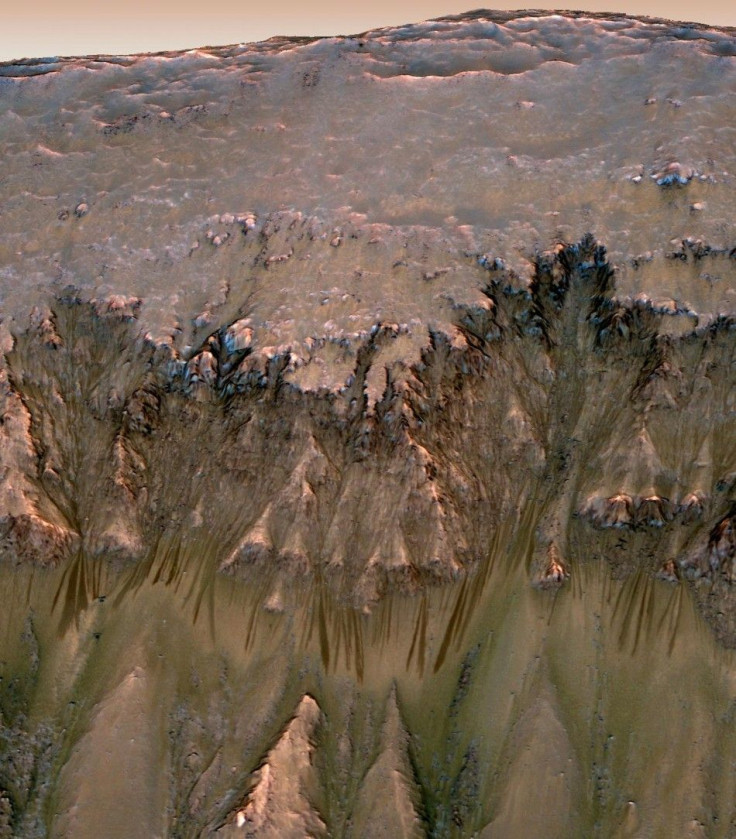Fresh Evidence of Possible Life on Mars : Water Found Flowing on Red Planet

Scientists have found new evidence of possible salt water flow on Mars, which could lead to traces of life being found on the red planet.
NASA scientists said on Thursday that they saw dark, finger-like features appearing and extending down some Martian slopes during late spring through summer, which fade in the winter and return during next spring.
The discovery was made when NASA’s Mars Reconnaissance Orbiter (MRO) recorded images and video footage of "finger-like" formations and features running down a number of Martian peaks.
After examining the images with those previously taken of the planet, researchers suggested that the possible liquid water on the planet would be extremely salty and lie under the surface. Temperature on Mars can go down to around 200 degrees below zero Fahrenheit (minus 128 degrees Celsius).
According to scientists, the extremely thin atmosphere on Mars could make liquid water above ground evaporate quickly. That's why scientists believe that any water on the planet would lie beneath the surface.
"It is our first chance to see an environment on Mars that might allow for the expression of an active biological process, if there is present-day life on Mars," said Lisa Pratt, biogeochemist at Indiana University, Bloomington. Pratt was one of the participants on the NASA panel discussing the results on Thursday.
The decades-long study of Mars has already established that water exists in the Red Planet in icy form, especially around its polar caps, and beneath the surface. But so far no investigation has shown Martian water flowing like a stream.
If the new finding confirmed then it would fundamentally change the understanding of Mars and would open leads in search for life on Mars.
"The best explanation for these observations so far is the flow of briny water," said Alfred McEwen of the University of Arizona, Tucson. McEwen serves as the principal investigator for the camera and lead author of a report about the findings released Thursday in the journal Science.
However, evidence for water flowing in Mars remain circumstantial. "We have no direct detection of water," added McEwen.
While puzzling elements remain, flows of liquid brine fit the features' characteristics better than alternate hypotheses, says NASA. Saltiness lowers the temperature of water that would otherwise freeze. Locations where water flows actively become warm enough, even in the shallow spots, to sustain liquid water that is about as salty as Earth's oceans, while pure water would freeze at the observed temperatures.
"It's a mystery now, but I think it's a solvable mystery with further observations and laboratory experiments," McEwen said.
Earlier studies have shown that salt deposits have existed abundantly in Mars. Besides, water traces were found by NASA's Phoenix Mars Lander in 2008.
"Water today on Mars was suggested previously, but it's not clear if those claims withstood follow-up studies ... That may prove true with this case as well, but for now, this is the best candidate for water today on Mars," McEwen said.
If there is life on Mars, it can be traced now with better precision, as it is certain that the briny water on the red planet will hold clues to extant life. "... if there is extant life on Mars, it might be accessible in these brines, which gives us a new direction as to where to go," said McEwen.
This is the closest scientists have gotten to finding evidence of liquid water on Mars. They have detected frozen water in many middle to high-latitude regions. However, until now no evidence has been found which suggests that there is flowing water on the planet.
Finding water on Mars has long been a search of NASA. If there is water, there is hope for life on the planet. The agency has been sending spacecrafts to Mars since the 1970s.
MRO has been orbiting the Red Planet since 2006. MRO is managed by the Jet Propulsion Laboratory, a division of the California Institute of Technology in Pasadena, Calif., for NASA's Science Mission Directorate in Washington.
© Copyright IBTimes 2025. All rights reserved.





















